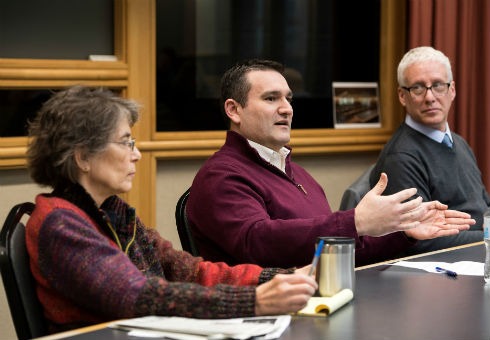
Health care reform: It’s a hot topic and the subject of ongoing national debate. David Brancaccio, host and senior editor of Marketplace Morning Report and the Wisconsin School of Business visiting business writer in residence, moderated a forum for WSB faculty to share their insights and expertise on health care economics.
Panelists included: Margie Rosenberg, professor of risk and insurance; Justin Sydnor, associate professor of risk and insurance; Anita Mukherjee, assistant professor of risk and insurance; and Enno Siemsen, professor of operations and information management.
Below are some takeaways from that conversation:
On catastrophic health plans
“Catastrophic,” “stripped down,” and “pared down” are all common terms that describe a type of minimum cost, high deductible individual health insurance plan. “To what extent can they work, or are they fraught?” Brancaccio asked panelists.
These types of plans are not a new concept, Rosenberg said. “Prior to the Affordable Care Act (ACA), there existed short term health plans covering basic needs that did not cover the essential benefits that ACA does cover.”

Mukherjee noted that while high-deductible health plans can be very costly, they also have the potential to expand coverage and reduce costs if people are seeking out preventive care earlier. If these originally short-term plans are substituting as long-term care, that could be a problem, Mukherjee says, particularly if families face unexpected health shocks that can lead to bankruptcy or serious financial complications.
Individuals who are relatively healthy and expect to continue to be healthy might be attracted to these stripped down plans, Sydnor said, because they are inexpensive. However, “the people who get hurt most by the introduction of these low-coverage plans are those with health problems and incomes that aren’t low enough to qualify for subsidies,” he said. “I think that’s the fundamental tension of this question. How much do we want to support this system of using healthier people paying into this system?”
On controlling costs and pharmaceutical companies
Strictly from a pharmaceutical company’s perspective, Siemsen said—not a defense of its practices—”every pharmaceutical manufacturer needs to have a strong economic interest in sustaining the production of pharmaceuticals. And the moment they lose that is the moment you are going to see drug shortages.” If they’re not making money on the drug, he explained, the drug will not receive a high priority in the production schedule.

From the customer side, one of the problems with prices and pharmaceutical companies, Sydnor said, is that they can exploit market power without fear of a consumer backlash like other industries face. If they’ve “sealed up the market” on a particular drug, they can raise the price without repercussions. “As a consumer, you can decide to take that drug or not take that drug, but you don’t have other ways to control that.”
On the Affordable Care Act
The Patient Protection and Affordable Care Act, known more widely as the Affordable Care Act, is a health care law signed by former President Barack Obama in 2010. Several attempts have been made to repeal, replace, and reform the law since then with little success. Brancaccio asked the panelists to weigh in on where the ACA stands now.
Sydnor says part of the problem is a lack of cohesive vision. “It’s sort of based in certain tensions that go unresolved,” he says. “I feel like you see a lot of broad support, even from President Trump, that echoes what you see from the population at large. People want to have guaranteed access to good health insurance regardless of whether they’ve been sick in the past. And people generally believe that there should be some help for low-income people in acquiring that.”
Siemsen noted that there are regulatory implications and a huge “distrust” of the health care market that makes forward movement difficult. “Health care is the textbook example of a market with incredible market failures for all kinds of reasons, which in and of itself means it has to be heavily regulated.”

Reaching consensus on health care may depend on our ability to localize, despite our differences, Rosenberg suggested. Research, she said, has shown that healthy communities affect job climate, education, and overall quality of life. “I like to think of population health and healthy communities as a group of people that band together at local levels—community, county, state—and work together to make our communities healthier.”
Even though there’s no immediate solution in sight, the debate around these issues is positive, Mukherjee believes. “I think we’re at a bit of a tipping point where there’s a lot of attention, a lot of experimentation around the country on how we can improve health care. It gives me optimism.”
Read about the blockchain and cryptocurrency panel moderated by David Brancaccio.
Tags: